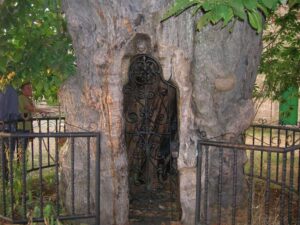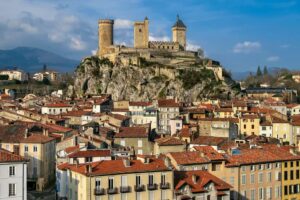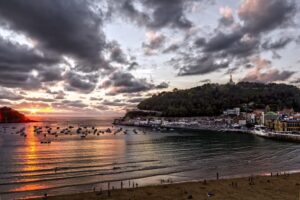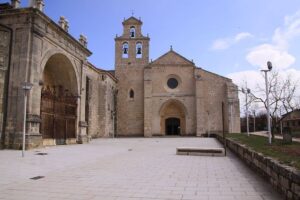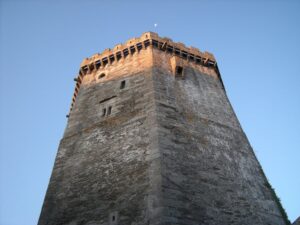
Bahamonde (officially Baamonde in Galician) is a small Galician village situated on the Northern Camino de Santiago, between Vilalba and Sobrado dos Monxes. With barely 300 inhabitants, this rural settlement in the Terra Chá region offers pilgrims some peculiar and historically rich places of interest.
Below, we explain what to see in Bahamonde and its surroundings, focusing on the needs and interests of pilgrims walking this Jacobean route. Before introducing this place, let us first discuss the Northern Way, the route on which this village is located.
Índice de contenidos
Why choose the Northern Way? A comparison with other Camino de Santiago routes
The Northern Way is one of the most iconic and yet least crowded Jacobean routes. It runs along the Cantabrian coast before entering Galicia, offering a unique combination of coastal and rural landscapes. Many pilgrims choose it for its views of the Cantabrian Sea, lush forests and the tranquil atmosphere of its stages.
For example, sections such as the Camino de Santiago from Santander to Gijón allow for enjoying stunning cliffs, secluded beaches and historic cities along the way.
That said, how does the Northern Way compare with other Jacobean routes? Each one has its own special charm:
- French Way: the most popular and busiest route, with a very well-developed infrastructure of hostels and services. Unlike the Northern Way, it crosses the interior of the Peninsula (the Pyrenees, La Rioja, the Castilian plateau and Galicia) and has a lively social atmosphere due to the large numbers of pilgrims.
If you seek constant companionship and numerous cultural stops, this might be your option; but if you prefer more tranquillity and milder summer weather, the Northern Way stands out in those respects.
- Original Way (Camino Primitivo): considered the original route. It is more mountainous and physically demanding, but also very solitary and authentic. By contrast, the Northern Way has moderate gradients (apart from some initial coastal stretches) and includes flat areas like the Terra Chá region in Lugo, where Bahamonde is located.
- Portuguese Way: this route comes from Portugal and can be walked via the inland route (via Tui) or along the Atlantic coast. It offers a highly interesting Spanish‑Portuguese cultural crossover.
-
- For instance, the Portuguese Way from Oporto to A Guarda follows the Atlantic coast from Oporto to A Guarda at the Spanish border, passing through fishing villages and coastal scenery. On entering Galicia, the stage from A Guarda to Santiago continues through the Rías Baixas, combining sea views with rural stretches until it joins the main Camino to Santiago.
In contrast, the Northern Way first traces the Cantabrian coast, then crosses the green landscapes of northern Galicia before merging with the French Way in Arzúa.
If you’re still undecided which route to choose or how best to plan it, there are specialist companies offering Camino de Santiago trips that can advise you. They handle the logistics (accommodation bookings, luggage transfer, etc.), allowing you to focus entirely on enjoying the walking experience.
Places of interest in Bahamonde
Although Baamonde is a small village without major tourist landmarks, it holds some points of interest well worth discovering, especially for pilgrims. The village has a few bars and basic shops, so it’s advisable to stock up here as services further on the route are limited.
Let’s take a closer look at what to see in Bahamonde and its surroundings:
Church of Santiago de Bahamonde
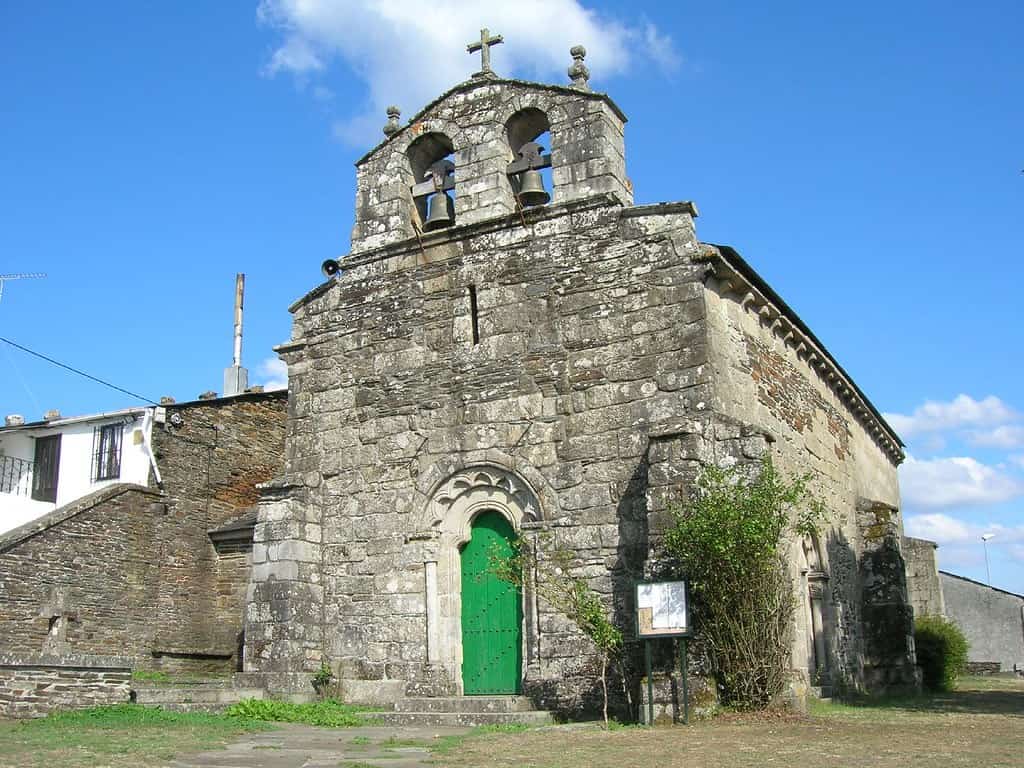
At the heart of the village stands the Church of Santiago de Baamonde, an ancient temple deeply tied to the Jacobean tradition. Records date a church here back to the 9th century, reflecting its long history of welcoming pilgrims.
The original Romanesque building was partially destroyed during the Irmandiño Wars (the Galician popular uprisings of the 15th century), but was later rebuilt and modified in subsequent centuries.
Today the church displays a blend of Gothic and Romanesque styles. The main façade features a doorway with simple archivolts and a pointed (ogival) window, reconstructed in the style of the medieval original. The layout is rectangular, built of local stone (granite at the corners and slate elsewhere), with lateral buttresses adding solidity and a simple bell gable atop.
Inside, if you get the chance to go in, you’ll find a peaceful interior with some ancient tombs in the main chapel. As the church is dedicated to Saint James the Apostle, pilgrims often enter to stamp their pilgrim passport and take a moment for spiritual rest. Check opening times, as it may only open during Mass or by asking a local resident.
In the churchyard (exterior) you’ll discover several interesting features:
- A group of three stone wayside crosses from the 17th century form a small Calvary. These carved crosses depict Christ’s Crucifixion with the Sorrowful Virgin. On the central cross the Christ figure has the left foot over the right (which is unusual), a curious detail for connoisseurs of sacred art.
- Very near these crosses, the church surroundings contain what is likely Bahamonde’s greatest treasure for pilgrims: its ancient tree, which we are about to describe with the importance it deserves.
The ancient chestnut tree and the “chapel” inside
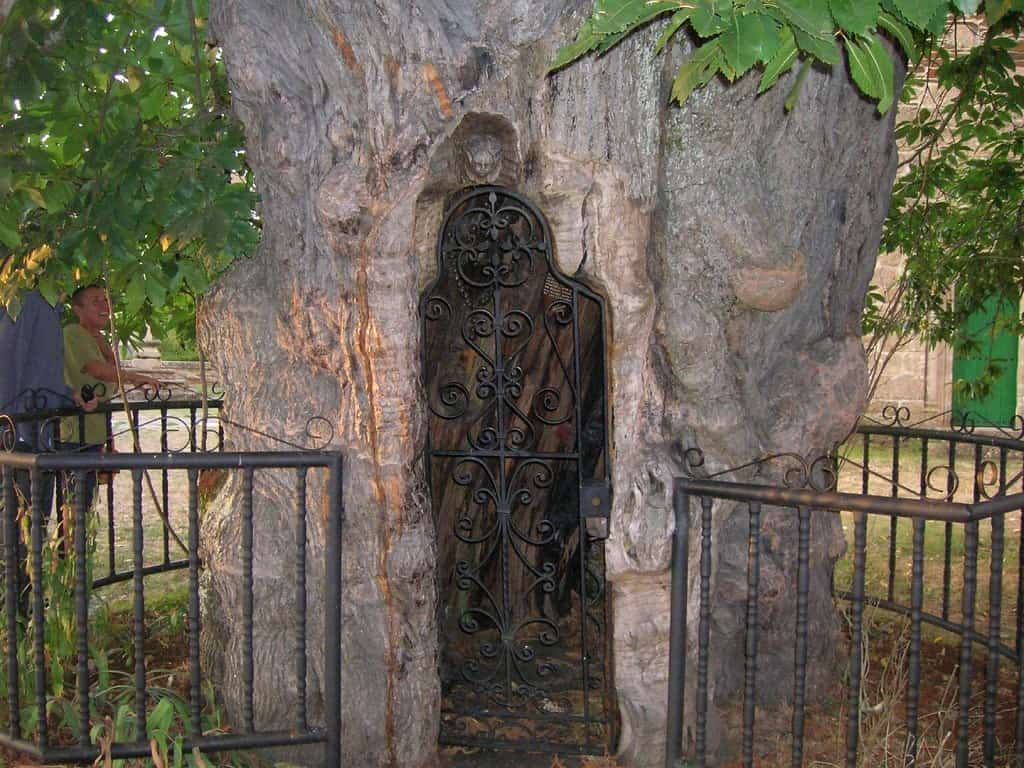
Next to the Church of Santiago stands an elderly chestnut tree of impressive proportions. At nearly 500 years old (some refer to it as millenary due to its venerable aspect), this monumental tree was almost lost in 1971 because of widening works on the N‑VI road passing through the village.
Fortunately, the determined action of a distinguished local resident, the sculptor Víctor Corral, saved the chestnut from being cut down and turned it into something truly unique: a chapel inside a tree.
This gentleman literally locked himself inside the hollow trunk during the works, preventing it from being felled. He used the opportunity to clean out the interior and carve a small altar in honour of the Virgin of the Rosary, patron saint of Baamonde, sculpting her image into the wood to create a kind of natural sanctuary.
Today pilgrims can peer into this thick chestnut (its trunk exceeds 6 metres in circumference) to see the carved sculpture within. Víctor Corral himself cared for the tree over many years: carving small figures (animals, hands and other motifs) into sections of the trunk as they dried, turning the chestnut into a living artwork in constant evolution.
Víctor Corral House‑Museum

The heroism of the chestnut tree leads us to the next point of interest: the Victor Corral Sculpture House-Museum. As we have just mentioned, Víctor Corral is a locally renowned sculptor with international acclaim, born in Baamonde in 1937, and his influence can be felt throughout the village.
Just a few metres from the church (around 100 m), you will find his house-studio, built at the end of the 20th century with the appearance of a traditional Galician manor house. This personal museum opens its doors to visitors and pilgrims who wish to learn about the artist’s work.
Inside the house-museum, a wide collection of his sculptures and creations is on display. There are pieces of religious and abstract art, mostly wood carvings showing exceptional craftsmanship, but also works in bronze, ivory, and other materials.
In addition to sculpture, the artist experimented with oil painting and watercolours, so the museum also contains some paintings and sketches. Walking through its rooms is to discover everything from delicate sacred figures to original compositions of fantastic animals, all with that dreamlike and detailed touch characteristic of Corral.
Entry is usually free or based on voluntary donation and it is family members who welcome you and share anecdotes about each artwork, making the visit very personal.
Ancient Fortress and Camarasa Tower
Bahamonde also has its chapter in the medieval history of Galicia through an ancient fortress that once existed in the village.
Next to the church stood the Baamonde Fortress, which included the so-called Camarasa Tower. This fortification was once owned by the Counts of Amarante and some historians believe it could have been one of the oldest fortresses in the province of Lugo.
Unfortunately, there is virtually nothing left standing of that medieval tower. It is known to have had a perimeter wall around 375 metres long, the remains of which were visible until the 20th century. In fact, the last remnants of the tower collapsed (or its stones were reused to build neighbouring houses) during the 20th century.
Today, only some stretches of wall are integrated into modern buildings and a defined area remains. In other words, don’t expect to find a towering structure or a recognisable castle; rather, it is the historical memory that survives. Even so, if you’re interested in medieval stories, it’s worth imagining what this site might have looked like centuries ago.
Natural Surroundings and Rural Tranquillity
Beyond the specific points already mentioned, the essence of Baamonde as an experience for the pilgrim lies in its authentic Galician rural environment. The village is located in the Terra Chá region, which means “flat land”: a vast green plain dotted with forests, meadows where cows graze, and winding rivers.
After walking through coastal or mountainous areas, many pilgrims appreciate the serenity of these flat Galician stages. Nearby, without straying too far from the Camino, you can enjoy the landscape: small oak and chestnut forests, ancient granaries next to the houses, and the sound of stream water accompanying the route.
If you have time and energy, a few kilometres away there are other places with natural charm. For example, on the stage towards Sobrado dos Monxes, you pass through villages like Miraz, Guitiriz, or Sendelle, where you will also find rural peace and ancient churches or medieval bridges hidden among the vegetation.
Gastronomy and Local Traditions in Bahamonde
As a pilgrim, it’s not just about monuments: gastronomy and local customs also enrich your journey along the Camino. Here, you can taste some typical Galician flavours, perfect for recharging your energy:
- Galician Broth: if you arrive on a cool or rainy day (quite common in the north), nothing is better than a steaming bowl of Galician broth, a traditional soup made from turnip tops (turnip greens), potatoes, beans, and lard. It is usually available on the daily menus of many rural bars.
- San Simón da Costa Cheese: this is a local speciality from Terra Chá, originating in Vilalba. It is a smoked cow’s milk cheese made with birch wood, with a mild flavour and creamy texture. Ask at the bar or grocery store in Bahamonde; with luck, they will have some San Simón to taste with Galician bread. A true local delicacy!
- Galician Empanada: another classic often found on bar counters. Tuna, meat, or cod with raisins are common fillings. It’s a perfect food to take along and eat during the stage.
- Galician Octopus (pulpo á feira): although octopus is more famous in places like Melide or at fairs, you can find it anywhere in Galicia. If you happen to pass by when there is a market or festivity, make sure to try a plate of tender octopus with paprika.
- Other Homemade Products: in Galician villages, pilgrims sometimes find spontaneous stalls from locals offering seasonal fruit, handmade bread, or even homemade sweets in exchange for a donation. Keep an eye out for these in the surroundings, as Galician rural hospitality often translates into small gastronomic treats along the Camino.
As for festivities and customs, Bahamonde keeps simple but deeply rooted traditions.
The village’s patron saint festival is held in honour of the Virgin of the Rosary every year, around September 11th. If you pass by during this time, you’ll find a lively atmosphere: special masses, a procession with the Virgin’s image (probably the same one depicted in the chestnut sculpture), street parties with music in the square, and food stalls.
Santiago Apostle (July 25th) is also venerated, as it is throughout Galicia, although Bahamonde’s major festival is in September.
If you arrive early in the afternoon, you might see older locals sitting at their doorsteps or in the bar, chatting in Galician about the harvest or their families. Don’t hesitate to greet them with a “Bos días” or “Boa tarde” or the typical “¡Buen Camino!”. The people of Bahamonde are usually kind to pilgrims, and many are used to seeing walkers passing by every day.
Final Tips for Pilgrims in Bahamonde
- Supplies: Bahamonde has only the basics in services. Make sure to buy water, fruit, or nuts at the local shop if you plan to continue towards Miraz or Sobrado without long stops. After Bahamonde, the next stage has long stretches without large towns, so it’s wise to carry some food.
- Enjoy the Slow Pace: Baamonde is a stop on the Camino where time seems to slow down. After days of walking, take a break here: sit under the millennium-old chestnut tree, chat with other pilgrims at the bar while sampling the local cheese, and watch the sunset over the meadows.
In summary, Bahamonde may not be a top tourist destination on its own, but as part of the Northern Way, it offers pilgrims authenticity, history, and rest. Its modest attractions leave a warm memory for those who pass through. ¡Buen Camino!

